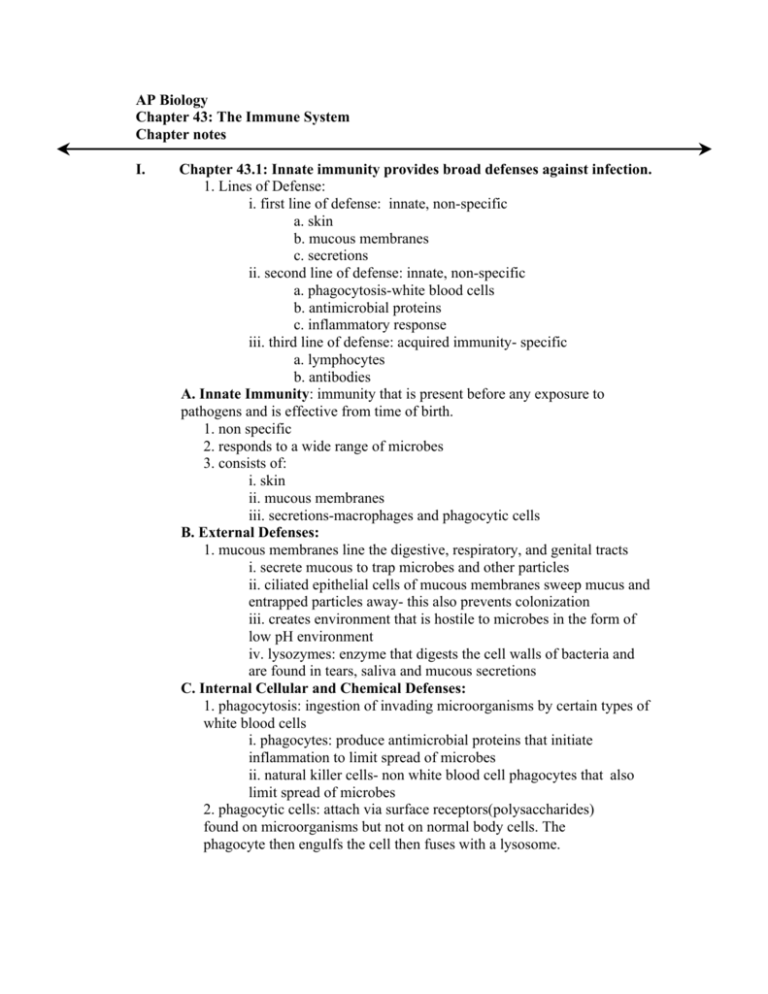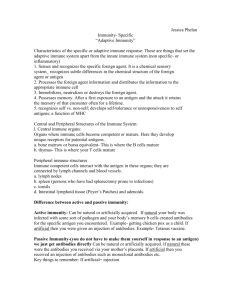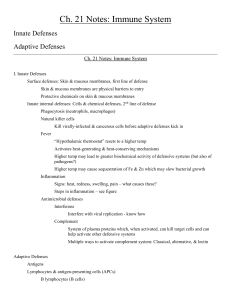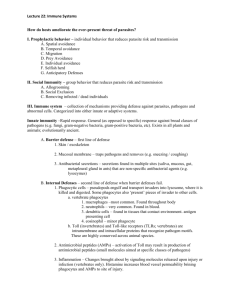AP Biology Chapter 43: The Immune System Chapter notes I
advertisement

AP Biology Chapter 43: The Immune System Chapter notes I. Chapter 43.1: Innate immunity provides broad defenses against infection. 1. Lines of Defense: i. first line of defense: innate, non-specific a. skin b. mucous membranes c. secretions ii. second line of defense: innate, non-specific a. phagocytosis-white blood cells b. antimicrobial proteins c. inflammatory response iii. third line of defense: acquired immunity- specific a. lymphocytes b. antibodies A. Innate Immunity: immunity that is present before any exposure to pathogens and is effective from time of birth. 1. non specific 2. responds to a wide range of microbes 3. consists of: i. skin ii. mucous membranes iii. secretions-macrophages and phagocytic cells B. External Defenses: 1. mucous membranes line the digestive, respiratory, and genital tracts i. secrete mucous to trap microbes and other particles ii. ciliated epithelial cells of mucous membranes sweep mucus and entrapped particles away- this also prevents colonization iii. creates environment that is hostile to microbes in the form of low pH environment iv. lysozymes: enzyme that digests the cell walls of bacteria and are found in tears, saliva and mucous secretions C. Internal Cellular and Chemical Defenses: 1. phagocytosis: ingestion of invading microorganisms by certain types of white blood cells i. phagocytes: produce antimicrobial proteins that initiate inflammation to limit spread of microbes ii. natural killer cells- non white blood cell phagocytes that also limit spread of microbes 2. phagocytic cells: attach via surface receptors(polysaccharides) found on microorganisms but not on normal body cells. The phagocyte then engulfs the cell then fuses with a lysosome. i. many microbes, such as Clostridium and Mycobacterium tuberculosis have mechanisms to either avoid detection from a phagocyte or resist chemical destruction in the lysosome. a. Clostridium has the ability to form an endospore which is resistant to natural defenses and drugs. b. During mitosis, one of the daughter cells will engulf the other and create a state of suspended animation that could last for thousands of years 3. leukocytes: phagocytic white blood cells- four types: i. neutrophils: most abundant(60-70%) that are attracted to and enter infected tissue. a. have a short life span of a few days because they self destruct during phagocytosis b. form puss do to the dead cells ii. monocytes: circulate in the blood for a few hours, then migrate(extravasate- or squeeze into tissue) into the tissues where they transform into macrophages iii. macrophages (big eaters): large long lived phagocytes that develop from monocytes a. 5% of white blood cells b. activated by phagocytosis through various internal signaling pathways c. some travel throughout the body others reside in areas such as the spleen, lymph nodes and other tissues of the lymphatic system d. can present peptide fragments from a wide variety of pathogens. iv. eosinopils- less frequent- defend against multicellular parasitic invaders by discharging destructive enzymes v. dendritic cells: can ingest microbes but main role is to stimulate acquired immunity a. main presenters of class II MHC molecules b. particularly effective in presenting antigens to naïve helper T cells(have not detected an antigen yet) c. trigger primary immune response d. located in epidermis and many other tissues e. migrate to lymphoid tissues where they present the antigen, via Class II MHC molecules to helper T cells f. . can present peptide fragments from a wide variety of pathogens. 4. antimicrobial proteins: i. complement system: (group of 30 serum proteins) a. inactive when microbes are not present b. in the presence of microbes a cascade of steps is triggered to activate this system which results in the lysis of microbes c. play a role in inflammation d. can activate acquire immunity ii. interferon: two types alpha-α and beta-β provide defense against viral infections a. limit cell to cell spread of virus by signaling other cells to produce inhibitory substances b. not virus specific c. gamma- γ interferon helps activate macrophages enhancing their ability for phagocytosis iii. defensins: secreted by activated macrophages, damage microbes using a broad range of mechanisms without harming body cells 5. inflammatory response: triggered by physical injury or entry of pathogens i. histamine: inflammatory chemical stored in mast cells, which release the chemical when injured a. triggers dilation and increased permeability of capillaries ii. activated macrophages and other cells discharge signal molecules known as prostaglandins which further promote blood flow and the inflammatory response iii. inflammatory response is critical to innate defense a. helps deliver antimicrobial proteins and clotting elements b. promotes release of histamine and attracts phagocytes to the site of injury c. allows for blood clotting to begin and further block the spread of microbes d. allows more neutrophils and monocytemacrophages to move from blood to injured tissue iv. chemokines: direct the migration of phagocytes and signals them to increase production of microbe killing compounds a. secreted by many types of cells: 6. systemic response to infection: i. increase in white blood cells ii. fever iii. septic shock 7. natural killer cells: patrol the body and attack virus – infected body cells and cancer cells i. surface receptors recognize general features on the surface of the target cells ii. once targeted, signals apoptosis D. Invertebrate Immune Mechanisms: examples: 1. sea stars posses amoeboid cells that ingest foreign matter by phagocytosis(3) and secrete molecules that enhance the defense response(3) 2. Drosophila melanogaster: exoskeleton- provides external barrier(3) 3. hemolymph- contains hemocytes which ingest microbes using phagocytosis(3)- and form a capsule around large parasites 4. the presence of pathogens signals other hemocytes to make and secrete(3) various antimicrobial peptides(similar to those that activate macrophages)(3) that bind and destroy the pathogen 5. some hemocytes contain phenoloxidase- an enzyme that converts phenols to reactive compounds that prevents the spread of microbes(similar to the cascade of steps that activate the complement proteins)(3) 6. sponges have the ability to distinguish between self cells and non-self cells which is a characteristic of the vertebrate acquired immunity. microbe more quickly- found in earthworms E. Plants(3)- defend against pathogens through molecular recognition 1. infection triggers chemical response that destroys infected and adjacent cells, localizing the effects. II. Chapter 43.2: In acquired immunity lymphocytes provide specific defenses against infection. 1. cytokines: proteins that help activate lymphocytes and other cells of the immune system 2. antigen: large molecules that elicit a response from the immune system 3. epitope(antigen determinant): portion of an antigen that is recognized by a lymphocyte i. antigen can contain many epitopes 4. antigen receptors consist of three general regions: i. transmembranous region- binds to plasma membrane ii. variable (V) region- antigen specific region- accounts for variability of lymphocytes iii. constant (C) region- make up the remainder of the molecule A. Antigen Recognition by Lymphocytes 1. Two types of lymphocytes: both circulate through the blood and lymph and are concentrated in the spleen, lymph nodes and other lymphoid tissues i. B lymphocytes (B- cells) ii. T lymphocytes (T-cells) 2. recognize antigens by means of antigen- specific receptors i. contain about 100,000 antigen receptors ii. receptors on a single cell are identical B. B Cell Receptors for Antigens: 1. Y-shaped molecules consisting of four polypeptide chains i. two identical heavy chains and two identical light chains linked by disulfide bridges ii. tail portion anchors receptor in the cell membrane iii. light and heavy chain portions- receptor area- amino acid sequence varies from one B-cell to the next iv. recognize intact antigens 2. Immunoglobulins: secreted antibodies similar to B cell receptors that lack the transmembrane region that anchors the B-cell to the plasma membrane C. T Cell Receptors for Antigens and the Role of the MHC: 1. T-cell receptors consist of two different polypeptide chains (γ and β) connected by disulfide bridges i. has a transmembranous region that anchors the receptor to the plasma membrane ii. α and β regions are the antigen receptor sites iii. recognize small fragments of antigens that are bound to normal cell- surface proteins called MHC molecules. 2. Major histocompatibility complex (MHC)- these molecules bind to fragments and bring them towards the cell surface- antigen presentation- a nearby T-cell can detect the antigen fragment- two classes of MHC molecules i. Class I MHC- found on almost all nucleated cells of the body a. when a body cell becomes infected or cancerous these molecules present or display the antigen b. the complex is then recognized by a subgroup of T-cells called cytotoxic T-cells ii. Class II MHC- made by dendritic cells, macrophages and B cells(known as antigen- presenting cells- because they display internalized antigen fragments to helper T-cells) a. molecules bind foreign materials that have been internalized and fragmented through phagocytosis or endocytosis b. the complex is then recognized by a another subgroup of T-cells called helper T-cells c. class II MHC molecules are mainly found on dendritic cells iii. MHC proteins are polymorphic- they contain a large number of alleles in the human population creating a broad array of MHC molecules 4. Lymphocyte Development: i. originate from pluripotent stem cells in bone marrow ii. if lymphoid stem cells migrate to the thymus they will develop into T-cells (T = thymus) iii. if lymphoid stem cells mature in the bone marrow they become B-cells(B = bursa of Fabricus or bone marrow) iv. clonal selection: activated stage of a lymphocyte after it binds to a specific antigen 4a. Generation of Lymphocyte Diversity by Gene Rearrangement: i. antigen receptors on B and T cells differ from one cell to the next ii. the variable (V) regions on the antigen binding site account for the diversity of the lymphocytes do to variation in the amino acid sequence iii. humans are said to have 1 million different B cells and 10 million different T cells each with a particular antigen binding site iv. gene segments that code for antigen receptors can undergo random, permanent rearrangement a. both light and heavy chains of the B cells and α and β chains of the T cells can undergo rearrangement 4b. Testing and Removal of Self- Reactive Lymphocytes: i. random rearrangement of antigen receptor genes means it is possible for the receptors to be specific for self cells and molecules ii. lymphocytes bearing receptors specific for molecules already present in the body are either destroyed by apoptosis or rendered non functional. iii. allows the immune system to regulate self tolerance iv. sometimes this system fails and diseases such as multiple sclerosis and rheumatoid arthritis occur 4c. Clonal Selection of Lymphocytes: clonal selection = each antigen, by binding to specific receptors selectively activates a tiny fraction of cells from the body’s diverse pool of lymphocytes which gives rise to clones of thousands of cells, all specific for and dedicated to eliminating that antigen i. a given antigen only reacts with few lymphocytes ii. when activation occurs, the lymphocytes are stimulated to divide many times and to differentiate, forming two clones of daughter cells a. effector cell- one of the cloned daughter cells that combat the same antigen- short lived b. memory cells- the other cloned daughter cell which are long living and carries receptors for the same inducing agent iii. primary immune response- the selective proliferation and differentiation of lymphocytes that occur the first time the body is exposed to a particular antigen a. peaks about 10-17 days after exposure b. plasma cells – effector B cells iv. secondary immune response- if individual is exposed again to the same antigen, the response is faster( 2- 7 days)- immunological memory 4d. Summary of Clonal Selection of Lymphocytes: i. antigen binds to antigen receptors of a specific B cell or T cell ii. the selected B cell proliferates forming a clone of identical cells bearing the same receptors iii. some of the proliferated cells develop into short- lived effector cell(plasma if B cell, helper T cell or cytotoxic T cell if T cell) that secrete antibodies specific for the antigen iv. some proliferated cells develop into long lived memory cells that can respond rapidly upon exposure of the same antigen III. Chapter 43.3: Humoral and cell- mediated immunity defend against different types of threats. 1. Acquired immunity has two branches: i. humoral immune response: which involves the activation of clonal selection B cells resulting in the production of secreted antibodies that circulate in the blood and lymph ii. cell- mediated immune response: involves the activation and clonal selection of cytotoxic T cells which directly destroy certain target cells A. Helper T Cells: A Response to Nearly All Antigens: 1. helper T cells encounter and recognizes a class II MHC- antigen complex: i. the helper T cell proliferates ii. the helper T cell differentiates into a clone of activated helper T cells(effectors) and memory T cells iii. CD4- surface protein that presents most helper T cells binds the Class II MHC molecules a.helps keep the complex together while the helper Tcell proceeds with destroying the target cell 2. helper T cells secrete cytokines stimulating other lymphocytes promoting humoral and cell- mediated response 3. helper T cells are subject to cytokines i. example- dendritic cells present an antigen to the helper T cell, they also release cytokines eliciting a release of more cytokines from the T cell. B. Cytotoxic T Cells: A Response to Infected Cells and Cancer Cells: 1. Cytotoxic T Cells: i. effectors for the cell- mediated immune response ii. eliminate intracellular pathogens and viruses, cancer cells and transplanted cells 2. Class I MHC presents fragments of non-self proteins are recognized by cytotoxic T Cells. i. CD8- protein present on most cytotoxic T Cells enhances the interaction between cytotoxic T cells and target cell a. helps keep the two cells in contact during activation of the cytotoxic T Cell b. analogous to CD4 and Class II MHC 3. cytotoxic T Cells are activated(differentiate into an active killer)when selected by the Class I MHC- antigen complex i. T cells then secrete proteins that act on and destroy the bound antigen ii. pathogen is then deprived of a place to reproduce and exposed to circulating antibodies iii. cytotoxic T Cell may then go on to destroy other infected cells with the same pathogen 4. cytotoxic T Cells deal with cancer cells in the same manner as other pathogens 5. some viruses and cancers decrease the number of Class I MHC molecules on affected cells providing a resistance to cytotoxic T cells by avoiding detection i. Natural Killer Cells provide back up to the cytotoxic T cells by inducing apoptosis in the virus infected or cancer cell C. B Cells: A Response to Extracellular Pathogens 1. antigens that elicit a humoral response are: i. proteins and polysaccharides present on the surface of bacteria, incompatible transplanted tissue, transfused blood cells, pollen and bee venom 2. humoral response involves: i. helper T cells secreting cytokines to activate B cells a. helper T cells would have been activated by the same antigen ii. B cell then proliferates and differentiates into a clone of antibody secreting plasma cells (effector) and a clone of memory B cells iii. when the antigen binds to the B cell receptor, it is internalized through receptor mediated endocytosis iv. antigen is then presented to the helper T cells. v. B cells presents only antigens it is specified for. 3. T-dependent antigens- antigens that induce antibody production only with the assistance of helper T cells 4. T- independent antigens- antigens that induce a B cell response without the involvement of helper T cells i. the antigen can stimulate the B cell enough to activate it without the presence of cytokines ii. generally weaker responses 5. most antigens contain multiple epitopes i. a single type of antigen can stimulate a variety of different B cells giving rise to thousands of plasma cells ii. plasma cells can secrete an estimated 2000 antibodies per second over the 4 -5 day life span D. Antibody-Modified Disposal of Antigens: 1. Viral Neutralization: antibodies bind to certain proteins on the surface of a virus blocking its ability to infect a host cell 2. Opsonization: antibodies binding to bacterium, coating its surface and enhancing macrophage attachment and increasing phagocytosis 3. Agglutination(clumping): forming bacteria and viruses into aggregates that can be readily phagocytosed by macrophages i. each antibody molecule has at least two antigen binding sites that can bind to identical epitopes on different pathogen particles, linking them together 4. Precipitation: antibodies cross-link soluble antigen molecules dissolved in body fluids forming immobile aggregates that are disposed of by phagocyte IV. Overview of Humoral and Cell-mediated immune response: A. central role of helper T cells in humoral and cell-mediated immune response: 1. dendritic cell engulfs and degrades a bacterium and displays the bacterial antigen fragments with ClassII MHC molecules 2. helper T cell binds to the complex with aid of CD4 which promotes secretion of cytokines 3. cytokines stimulate proliferation of helper T cells gives rise to a clone of activated helper T cells 4. clone cells secrete other cytokines that activate B cells and cytotoxic T cells B. the killing action of cytotoxic T cells (cell mediated immune response): 1. specific cytotoxic T cells binds to Class I MHC antigen complex with the aid of CD8 2. this action and cytokines released from helper T cells activate the T cytptoxic cell 3. the activated cytotoxic T cells release perforins which form pores in the target cell membrane and proteolytic enzymes which enter the cell via endocytosis 4. the granzymes(proteolytic enzymes) initiate apoptosis 5. defends against intracellular pathogens and cancer C. Humoral Immune Response: 1. macrophage engulfs and degrades and displays it with Class II MHC molecules. 2. a helper T cell recognizes the complex becomes activated with the aid of cytokines secreted by the macrophage forming a clone of activated helper T cells 3. a B cell that has taken up and degraded the same bacterium displays Class II MHC -antigen complex 4. an activated T cell binds to the B cell 5. B cell becomes activated with the help of cytokines 6. activated B cell proliferates and differentiates into memory B cells and plasma cells(secrete antibodies) 7. humoral immune response defends against extracellular pathogens V. Chapter 43.4: the immune system’s ability to distinguish self from nonself limits tissue transplantation. VI. Chapter 43.5: Exaggerated, self directed,or diminished response can cause disease. A. Allergies: responses to certain antigens called allergens 1. involve antibodies of the IgE class i. response to antigens on the surface of pollen grains(hay fever) ii. causes the release of histamine and other inflammatory agents a. histamine cause dialysis and increased permeability 2. anaphylactic shock: widespread mast cell degranulation causing abrupt dialation of peripheral blood vessels causing a precipitous drop in blood pressure B. Autoimmune diseases: immune system loses tolerance for self and turns against certain molecules of the body 1. involves the generation of autoantibodies 2. lupus, rheumatoid arthritis, insulin dependent diabetes, multiple sclerosis 3. AIDS- Acquired Immune Deficiency Syndrome i. HIV (human immunodeficiency virus) ii. AIDS arises from the loss of helper T cells impairing the humoral and cell mediated immune response iii. CD4 acts as a HIV receptor and fusin acts as a co- receptor 4. Once inside the cell, HIV RNA genome is reversed transcribed and the product DNA is integrated into the host cells genome









